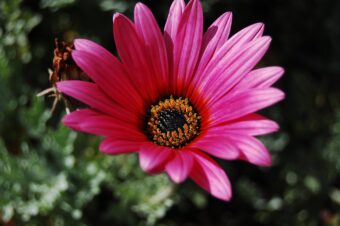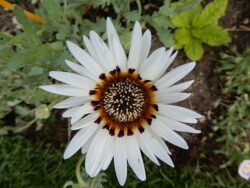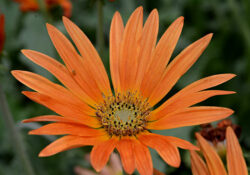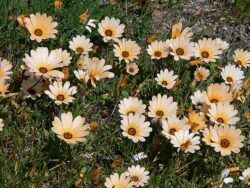In this article, we will discuss how to grow the annual or tender perennial plant of Arctotis in containers. Arctotis belongs to the family Asteraceae, where up to 20 species are known to exist. It is native to areas in South Africa, where it grows on stony slopes. Its common name is African or Cape Daisy and typical of plants from this region. The plants have daisy-like composite flowers that tend to close in late afternoons or on cloudy days.

True plant breeding has created a number of cultivars for use in the garden that tends to stay open for longer. They are tender perennials grown as half-hardy annuals in the UK.
It is a showy plant with striking large daisy-like flowers that come in white, yellow, blue, orange, red and purple borne on long branching stems. The flowers appear above attractive grey, narrow leaves. Some varieties have coloured central discs and some have coloured bands but the flowers appear throughout the summer.
As it is not a popular annual you will need to grow from seed if you can find a suitable supplier. Although now more suppliers are selling young plants so you can give them a try. Find out how to grow Arctotis in this article.
ARCTOTIS IN CONTAINERS
You can grow Arctotis from seeds or from garden-ready plants, where the choices are very much limited.
GROWING ARCTOTIS FROM SEED
You can sow seeds from February to April to flower from July to October. To get the best results sow seeds indoors. First, fill a seed tray with a good quality seed sowing compost. Water it until the compost is moist. Sprinkle the seeds thinly on the surface of the compost and just cover them with a thin layer of sieved seed compost or vermiculite. Firm the seeds down and place a propagator lid over the seed tray.
Place it on a heat mat or a propagator and after 21 to 35 days the seeds should emerge. Allow the seedlings to grow on and when they are large enough to handle, you can transplant them individually to 7.5cm pots full of multipurpose compost. Allow them to grow on and in Mid-May, you will need to harden them off before planting out in late May.
At this stage, you can treat your shop-bought plants or home-reared garden seeds in exactly the same way.
TIME TO CHOOSE A CONTAINER

First, choose a container that is within the proportions of the plant in question. If more than one plant is planted in the same container, you will get more impact. More colour will result in more impact. Space the plants 15cm apart, so a big container is recommended.
Whatever container you use make sure it has plenty of drainage holes. To the bottom of this container add a 1cm layer of gravel to allow the excess water to drain away. On top of this make a light growing media by mixing 70% by volume multipurpose compost with 30% by volume with perlite. Mix it well and then add it to the container to within 5cm of the rim.
Dig a hole or holes in the growing media slightly bigger than the root ball it came in the original container. Drop the plant in so that the top of the root ball is at the same level as the top surface of the compost. Backfill with the growing media ensuring that no gaps remain (you may have to fill it with more compost). Firm the plant(s) in and water well.
GROWING CONDITIONS
Place the container in a sheltered sunny spot, where it is protected from frosts and heavy rain. You will need to water regularly during the summer season and especially when 5cm below the top surface of the compost feels dry to the touch.
Once established it can take drought pretty well. Once the flowers buds start to form, you can start to feed the plant with a high potash liquid fertilizer every few weeks to encourage them to produce better quality blooms.
Once blooms are spent, you can deadhead them to encourage new blooms to form. Some species can get tall and may require support, especially in windy conditions.
PESTS AND DISEASES

Arctotis seem to be trouble-free in both terms of pests and disease. Saying that aphids may target young plants. To deal with them, spray at high velocity with jets of water to try blasting them off. If they are too many of them, you can use a systematic insecticide to try to keep the pests down.
VARIETIES TO GROW
The most likely variety to find is Arctotis x hybrida which produces large flowers in a mix of colours from white, red, bronze, yellow and orange. The flowers have a contrasting disc.
Varieties to look for are ‘Harlequin Mixed’, ‘Wine’ that has bright red flowers, ‘Flame’ that has red flowers, ‘Holly’ has deeper red flowers and ‘T and M’ hybrids.

Arctotis breviscapa produces flowers with orange petals with black/purple centres.
Arctotis grandis produces white/pastel petal flowers with a central blue disc with a yellow band.
Arctotis stoechadifolia also produces white flowers that are blue in the centre.
CONCLUSIONS
In this article, we have discussed how to grow the wonderfully delightful half-hardy annual of Arctotis in containers. They are easy to grow from seed (and cheaper too) and you will have a greater range of choice than if you buy garden-ready specimens.
Do not need much care provided you water regularly and feed once a fortnight with a liquid high potash fertilizer.
A cheerer plant to have in your container display. If you have any questions or comments that you have in growing Arctotis in containers, please do so in the comment box below.
Happy Arctotis growing.

what size pot should be used for plug in ?
Hi
For plugs I would use 7.5cm pots as it can be potted on later.
Thanks
Antonio